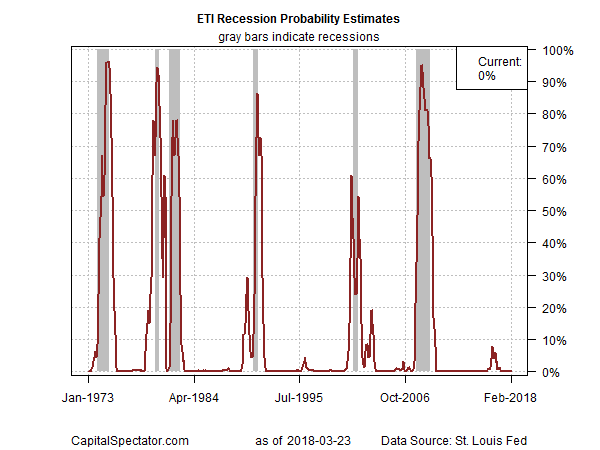US Business Cycle Risk Report - Friday, March 23
Fears of a global trade war are rattling stock markets around the world after President Trump imposed tariffs on China on Thursday. China’s commerce ministry responded immediately with tariffs on US imports. If trade restrictions escalate, there will be a price to pay in economic growth and so this evolving news story deserves close attention for monitoring macro risk. For the moment, however, using data published to date, US recession risk remains virtually nil.
The first round of the February economic profile is nearly complete and the numbers show that the macro trend was solidly positive. As a result, it’s highly likely that Monday’s February update (March 26) of the Chicago Fed National Activity Index will confirm that the economic expansion remained intact through last month.
Looking into the immediate future still paints an upbeat outlook. It’s unclear how or if the trade-war factor will change this calculus, but for now the US economy still enjoys a moderate tailwind.
Keep in mind, however, that the growth estimates for first-quarter GDP growth have been downgraded recently, even before trade risk became a real and present danger. The Atlanta Fed’s GDPNow estimate for Q1, for instance, dipped to a relatively weak 1.9% increase (as of March 16), which is below the moderate 2.5% gain in 2017’s Q4. If GDPNow’s analysis is correct, US economic activity is on track to post the softest increase in a year. The possibility of trade-related headwinds in the months ahead raises the risk that any deceleration will spill over into Q2.
Nonetheless, the rear-view mirror speaks loud and clear at this point. The Capital Spectator’s estimate of recession risk for the US points to a low probability that a new downturn started last month, based on a diversified set of economic indicators. (For a more comprehensive review of the macro trend on a weekly basis, see The US Business Cycle Risk Report.)

Aggregating the data in the table above continues to translate into a strong positive trend overall. The Economic Trend and Momentum indices (ETI and EMI, respectively) remain well above their respective danger zones (50% for ETI and 0% for EMI). When/if the indexes fall below those tipping points, the declines will mark clear warning signs that recession risk is elevated and a new downturn is likely. The analysis is based on a methodology that’s profiled in my book on monitoring the business cycle.

Translating ETI’s historical values into recession-risk probabilities via a probit model also points to low business-cycle risk for the US through last month. Analyzing the data in this framework indicates that the odds remain effectively zero that NBER will declare February as the start of a new recession.

For insight into the near-term outlook, consider how ETI may evolve as new data is published. One way to project values for this index is with an econometric technique known as an autoregressive integrated moving average (ARIMA) model, based on calculations via the “forecast” package in R. The ARIMA model calculates the missing data points for each indicator for each month — in this case through April 2018. (Note that December 2017 is currently the latest month with a full set of published data for ETI.) Based on today’s projections, ETI is expected to remain well above its danger zone through next month.

Forecasts are always suspect, but recent projections of ETI for the near-term future have proven to be reliable guesstimates vs. the full set of published numbers that followed. That’s not surprising, given ETI’s design to capture the broad trend based on multiple indicators. Predicting individual components, by contrast, is subject to greater uncertainty. The assumption here is that while any one forecast for a given indicator will likely be wrong, the errors may cancel out to some degree by aggregating a broad set of predictions. That’s a reasonable view, or so one can argue based on the generally accurate historical record for the ETI forecasts in recent years.
The current projections (the four black dots in the chart above) suggest that the economy will continue to expand. The chart above also includes the range of vintage ETI projections published on these pages in previous months (blue bars), which you can compare with the actual data (red dots) that followed, based on current numbers.
Disclosure: None.



